Sealife guideThe atlantic horseshoe crabLimulus polyphemus
Last updated on 03/24/2025 at 11:54 PM
Present on the Earth's surface for hundreds of millions of years, as evidenced by fossils, the atlantic horseshoe crab is among the oldest species still alive today ! Directly from prehistoric times, its morphology has remained unchanged, making the atlantic horseshoe crab a living fossil and a testament to the past. The atlantic horseshoe crab is essentially a prehistoric crab and like crabs belongs to the phylum Arthropoda.
Taxonomy
- Common name: Atlantic horseshoe crab
- French name: Limule
- Scientific name: Limulus polyphemus (Linnaeus, 1758)
- Family name: Limulidae
- Order name: Xiphosurida
- Class name: The horseshoe crabs [Merostomata]
Description
At first glance, the atlantic horseshoe crab's smooth appearance, color and shape resemble a heavy metallic soldier's helmet. But a closer look reveals a distinctive shape in its front carapace which gives it the english name « horseshoe crab ».

On the head of the atlantic horseshoe crab, two small eyes emerge on the smooth surface of the carapace
Its body is covered by a carapace made up of two distinct, articulated parts, extended by a spine.
On the head, two small eyes emerge on the smooth surface of the largest carapace. The rear carapace is narrower and bordered by numerous movable spines on either side.
The atlantic horseshoe crab is bluish-gray and averages about 20 inches in length for females. Males are smaller.
Range
The species Limulus polyphemus is the most common horseshoe crab species. This species is found along the western Atlantic coast from Nova Scotia in the north to Florida in the south and along the Gulf of Mexico.
If you visit Florida, check out the Ding Darling Wildlife Refuge on Sanibel Island near Fort Myers, where you might see atlantic horseshoe crabs along the shoreline !
Habitat
Atlantic horseshoe crabs inhabit shallow waters along the coasts on sandy or even muddy bottoms.
Diet
They primarily feed on small invertebrates found by digging through sand or mud.
Reproduction
In spring, atlantic horseshoe crabs move closer to shore to breed, and large gatherings can be observed. The male mates with the female, who then deposits fertilized eggs in a nest dug into the sand. The eggs hatch about a month later.
Did you know ?
A remnant of the past, horseshoe crabs today are represented by four known species. As mentioned, the first species Limulus polyphemus lives along the western Atlantic coast and in the Gulf of Mexico. The other three species - Carcinoscorpius rotundicauda, Tachypleus gigas and Tachypleus tridentatus - are found along the coasts of southeast Asia. All four species share similar characteristics.
Unlike most living species, the horseshoe crab has blue blood. While red blood color is due to the presence of hemoglobin, blue blood results from hemocyanin, a protein that like hemoglobin transports oxygen but contains copper instead of iron.
The horseshoe crab's blue blood is highly sought after in the medical and pharmaceutical fields for its clotting properties when exposed to bacteria.
Tips for observing
You can observe atlantic horseshoe crabs in shallow waters along mangrove-lined shores.

During the breeding season, the male atlantic horseshoe crab mates with the female. Observe the size difference between the male and the female !
Explore also

Mediterranean spider crab
(Maja squinado)
(Maja squinado)

Coconut crab
(Birgus latro)
(Birgus latro)

Gulf of Mexico golden crab
(Chaceon fenneri)
(Chaceon fenneri)
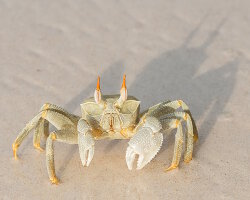
Indo-pacific ghost crab
(Ocypode ceratophthalmus)
(Ocypode ceratophthalmus)

Soft coral porcelain crab
(Lissoporcellana nakasonei)
(Lissoporcellana nakasonei)
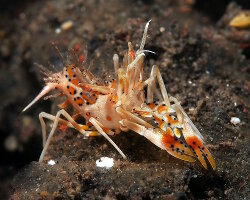
Tiger shrimp
(Phyllognathia ceratophthalma)
(Phyllognathia ceratophthalma)

Velvet swimming crab
(Necora puber)
(Necora puber)
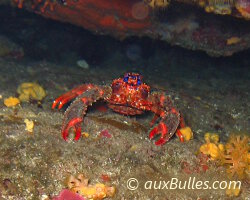
Spinous squat lobster
(Galathea strigosa)
(Galathea strigosa)
Our latestUpdates
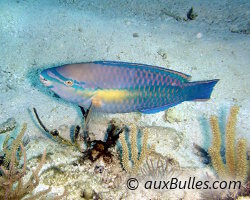
Thursday, August 7th 2025
The princess parrotfish
The princess parrotfish stands out with a coloration fit for a princess, featuring a dominant bluish hue, with yellow along the central part of its body near the pelvic fins, transitioning into green. Two blue bands run across its head on either side of its eyes.

Monday, August 4th 2025
The batwing coral crab
Discover the batwing coral crab, an iconic species of Caribbean coral reefs, recognizable by its smooth red shell speckled with white and cream.

Thursday, July 31st 2025
The spanish hogfish
The spanish hogfish is known for its vibrant colors, featuring a bright yellow body with a bluish to purplish area along its back. It inhabits the tropical and subtropical waters of the western Atlantic ocean, from southern Florida to Brazil, including the Gulf of Mexico and the Caribbean sea.
Photo of the Day
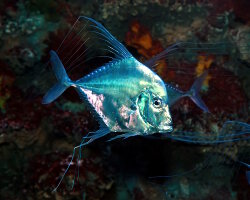
Cordonnier plume
(Alectis indica)
(Alectis indica)


